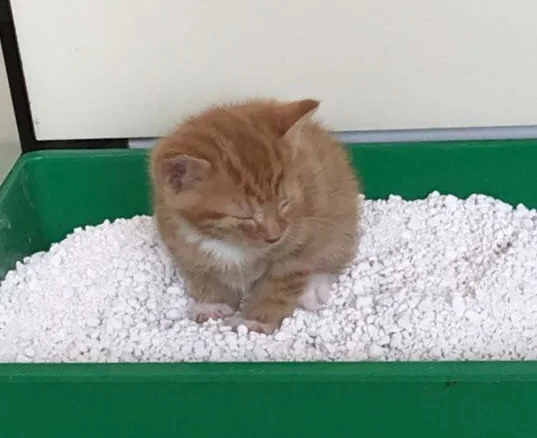Note: We may earn a commission from helpful, relevant links in our content. No cost to you. See our privacy policy.
Training your little furball to use the litter box can be a daunting task, especially if you’re new to the world of kittens.
But rest assured, it’s not hard, and it’s a crucial step in ensuring a happy, hygienic home for both you and your feline friend.
With a little patience, guidance, and our expert tips, you’ll have your kitten using the litter box like a pro in no time. So, let’s get your paws dirty and dive into the world of litter box training!
For adult cats, follow adult cat litter box training guide.

When Should You Start Litter Box Training?
The best time to start litter box training is as soon as you bring your kitten home. Most kittens are ready to begin learning around 8 weeks of age, but some may start showing interest even earlier.
The key is to be proactive and make litter training a priority from day one. This way, your kitten will quickly learn good habits and be well on their way to becoming a responsible litter box user.
Setting up for Success: Kitten-Friendly Boxes
To set your kitten up for success, you’ll want to create a comfortable and inviting environment for them to do their business.
Choose a litter box that is easily accessible and has low sides, making it easy for your kitten to climb in and out. Place it in a quiet, low-traffic area of your home to give them a sense of privacy and security.
You can also experiment with different types of litter to find the one your kitten prefers. Remember, the more inviting the litter box, the more likely your kitten will be to use it consistently, setting the stage for a smooth training process.
Guiding Your Kitten: Step-By-Step Training
Step 1: Introduce the Litter Box
Introduce your kitten to the litter box by gently placing them inside it. Let them sniff around, scratch, and explore.
Be patient and don’t force them to stay in the box if they seem uncomfortable. It’s essential to give your kitten time to familiarize themselves with the new environment.
Step 2: Encourage Digging Behavior
Kittens have a natural instinct to dig and bury their waste. To encourage this behavior, you can gently take their front paws and mimic digging motions in the litter.
Make sure to praise them and offer positive reinforcement when they exhibit this behavior on their own.
Step 3: Monitor for Signs
Keep an eye on your kitten for any signs that they may need to use the litter box, such as sniffing the floor, circling, or squatting. When you notice these signs, gently guide your kitten to the litter box and allow them to do their business.
Step 4: Praise and Reward
When your kitten successfully uses the litter box, be sure to offer lots of praise and even a small treat as a reward. Positive reinforcement will help cement the behavior and encourage your kitten to continue using the litter box.
Step 5: Keep the Litter Box Clean
Kittens, like adult cats, prefer a clean environment for their bathroom needs. Make sure to scoop the litter box daily and change the litter completely at least once a week.
A clean litter box will be more enticing for your kitten to use and will help prevent any accidents outside of the box.
Step 6: Be Consistent and Patient
Litter box training takes time, and every kitten learns at their own pace. Stay consistent with your training routine, and be patient as your kitten learns.
Remember that setbacks may occur, but with dedication and persistence, your kitten will soon master the art of litter box use.

Troubleshooting: What if My Kitten Doesn’t Use the Box?
If your kitten isn’t using the litter box, don’t worry – it’s not uncommon for kittens to face some challenges during the training process. Here are some practical suggestions to help get your kitten back on track.
- Reassess the Litter Box Setup. Make sure the litter box is easily accessible, placed in a quiet, low-traffic area, and filled with an appropriate amount of kitten-safe litter. If you have multiple kittens, ensure there are enough litter boxes available – one for each kitten, plus one extra.
- Experiment with Different Litter Types. Some kittens may have preferences for a particular litter type. Try different varieties, such as clumping, non-clumping, or natural materials like corn or wood, to see if your kitten has a preference.
- Monitor Health. If your kitten is consistently avoiding the litter box, it may be due to an underlying health issue. Keep an eye out for signs of discomfort, and consult your veterinarian if necessary.
- Limit Distractions. Ensure that the area surrounding the litter box is free from loud noises, strong scents, or anything else that could potentially startle or distract your kitten while they’re trying to use the box.
- Positive Reinforcement. Continue to offer praise and rewards when your kitten uses the litter box. Consistent reinforcement will help them associate the box with a positive experience, making it more likely they’ll continue to use it.
- Patience and Consistency. Remember, litter training takes time, and every kitten is different. Stay patient, consistent, and understanding as you help guide your furry friend to successful litter box use. This is especially true for new cats who are still acclimating.
My cat and litter box:
To learn more about the tips and solutions for fixing cat litter box issues, check out our guide here. We also have a quick guide for kittens giving you trouble by using older cat’s litter box.
Last but not least, here’s a helpful video with some practical tips from the Kitten Lady:
FAQs
At what age should I start litter training my kitten?
Begin litter training your kitten when they are around four weeks old, as this is when they start developing the necessary motor skills and instincts.
How long does it take to litter train a kitten?
Litter training typically takes two to three weeks, although each kitten is different and may require more or less time to become fully accustomed to using the litter box.
Can I use a specific type of litter for kitten training?
Yes, it’s best to use a non-clumping, unscented litter for kitten training, as it is safer and gentler on their sensitive paws and respiratory systems. World’s Best Original Unscented is one of the best choices as it’s almost completely dust-free, doesn’t turn into mud, and has no smell.
What if my kitten refuses to use the litter box?
If your kitten refuses to use the litter box, try adjusting the box’s location, experimenting with different litter types, monitoring their health, and providing positive reinforcement to encourage proper use.
Alex, a passionate animal lover, has experience in training and understanding animal behavior. As a proud pet parent to two dogs and three cats, he founded AnimalReport.net to share insights from animal experts and expand his knowledge of the animal kingdom.








